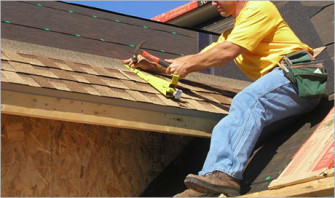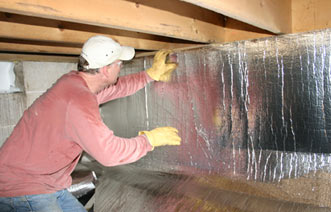Snuff These 5 Ticking Time Bombs in Your Home
 There are some maintenance and repair issues that homeowners just hate to deal with — either because they take time, or cost money, or just don’t seem, well, urgent. But some of these problems can become ticking time bombs, poised to explode if they’re not defused early, when they are more like firecrackers than bombs. Here are some of the top structural and mechanical time bombs in your home that experts say have the potential to blow up and are worth squelching now — before the big boom.
There are some maintenance and repair issues that homeowners just hate to deal with — either because they take time, or cost money, or just don’t seem, well, urgent. But some of these problems can become ticking time bombs, poised to explode if they’re not defused early, when they are more like firecrackers than bombs. Here are some of the top structural and mechanical time bombs in your home that experts say have the potential to blow up and are worth squelching now — before the big boom.
Foundation
Houses settle. But not all settling is the same. A lot of times people will ignore the cracks in the brick veneer on the outside of the house, even when they get to be a half-inch or more. Even though that brick is often just the “skin” of the house, a crack that large can signal much deeper problems with a moving foundation.Some cracks in your house are essentially cosmetic, the result of natural settling. When is a crack something more? If you see a crack big enough to put a No. 2 pencil in, you’re looking at a problem. Other signs of trouble: a tilting chimney or windows and doors that stick or jam, which can be caused by a moving foundation that is twisting their frames. If you suspect foundation issues, hire a structural engineer to evaluate your house. Caught early, a repair might cost a few thousand dollars. Caught too late, the tab could run $20,000 to $50,000.
Roof
Most people don’t pay any attention to their roof until they see water coming through the ceiling! But if you see drips in your living room, the problem is already far gone. A new roof could cost you upwards of $8,000 to $10,000. Some people say, ‘I’ve got a 20-year shingle, it’s gonna last 20 years.” About every five years you should have the roof inspected. One of the telltale signs of a wearing roof is coarse sand pooling at the base of gutter downspouts; the sand is most likely the granules of the shingles washing off. If you see a lot of it, then it’s a good idea to have someone climb higher. If you can safely get on the roof (be careful!) and the surface feels slippery, that’s another sign that the shingle material is coming off. 
You can find evidence of additional problems under the roof. Water will usually enter the attic first. Hire an inspector, or look for stains around the chimney and the stack vents, or around other venting pipes that exit the house. Those are places where the metal flashing can fail. Also, look around the attic for wet and, or damaged insulation. Discovering issues early on could mean the difference between repair and replacement — or a few hundred dollars rather than thousands.
Septic System
Homeowners who have septic tanks don’t always like to think about them. That’s a mistake. Generally speaking, a septic system breaks down the solids and liquefies them. The liquid then goes out into lines and is dispersed into the surrounding ground. But other materials also reach the septic tank — from sanitary napkins and cigarette butts to foodstuffs such as coffee grounds and grease (particularly if you have a garbage disposal). Over time, the baffles that stop the larger solids from going into the lines can get blocked. If that happens, the system can back up into your house.
If you have a septic tank, have the tank pumped every five years — if you have a garbage disposal, you might want to have it done every three years. It’s really relatively inexpensive to have it pumped. Many contractors will pump it and inspect it at the same time. It’s particularly cheap when compared with the cost of digging up your yard to repair your system, which can run thousands of dollars.
Aged Electrical Systems
Homes built after World War II, as well as homes built earlier, didn’t have the same requirements for power that we do now. Homes built today can’t have more than 12 linear feet of space between electrical outlets. This stipulation was intended to minimize the use of extension cords, which can cause fires. The electrical systems of older homes, particularly those outfitted with lots of appliances and amenities, just can’t handle modern electrical demands. Sockets can actually wear out, and switches, too. Breakers become less reliable as they age. The upshot can be a fire.
About every 20 years, a home should have a thorough inspection of its electrical system. Homes built prior to 1980 should definitely be looked at. You could call an electrician, but an electrician may see it as a sales call. Like any trade, they’re there to fix things. Another alternative: Consider calling an experienced home inspector.
 Crawl Space
Crawl Space
Few homeowners ever pay attention to their crawl space, that often dank, dirt-floored area beneath many homes. The crawl space is sort of a window into the belly of your home and all its inner workings. It could reveal all sorts of problems before they get bigger:
- You might have a leak in the bathroom under the commode or in a supply line that could be weakening the floor, and you’d never know it until the day a sag appears in the floor and you need major repairs.
- Termite damage can usually be seen there before it appears elsewhere.
- Many crawl spaces carry the heating and air-conditioning ductwork that runs throughout a house. But when repairmen clamber about in this cramped space, over time they might cause some damage to the insulation or to the ductwork.
Homeowners should periodically spend a few minutes with a flashlight looking inside the crawl space as a precautionary measure. Occasionally hire a home inspector to do a more thorough examination of the space. An inspector can look for leaks in plumbing and find faulty or damaged ductwork and worrisome wiring. As well, while often not licensed to inspect for termites, an inspector usually knows enough to point out suspected trouble and recommend treatment or repair.

